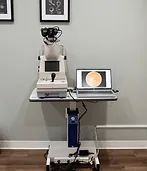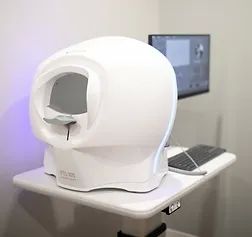Ocular Disease & Injury
Our deepest passion is to protect your eyes and ensure a lifetime of healthy vision. With our advanced ocular imaging technology we can detect early abnormalities and prevent changes in vision before they occur. We provide advice on proper eye nutrition as well as healthy visual and lifestyle habits.

We treat common conditions like eye infections, ocular allergies, and styes (hordeolums) as well as more significant ones. Annual exams are
recommended to find early signs of eye disease before visual symptoms are present.
Cataracts
A cataract is a clouding of the natural lens of the eye that causes changes in vision. Common symptoms are blurred vision, faded vision, poor night vision, glare or haloes, double vision, and frequent prescription changes.
Diabetic Eye Disease
Patients with Diabetes can experience ocular side effects due to increased blood sugar damaging the fine blood vessels of the retina. Anyone diagnosed with Pre-Diabetes or Diabetes should have annual dilated exams to evaluate the retinal vessels. If signs of Diabetic Eye Disease are caught early, they may be managed by a change in medication, lifestyle and diet changes, and ocular medications. It is important to catch these changes as early as possible because more progressed disease can cause permanent vision loss. Symptoms can include blurry vision, fluctuating prescriptions, flashes of light, spots in vision, areas of vision loss, and dark vision.

We will often take a retinal photograph for our patients with Diabetes. This allows us to see how the retina changes over time and allows us to catch changes in retinal vascular health early which can prevent changes in vision and blindness.
Glaucoma
Glaucoma is a group of diseases that cause damage to the optic nerve, located at the back of the eye. The optic nerve is responsible for relaying visual information to the brain. Oftentimes, the pressure inside the eye increases and this causes the damage. Unfortunately, we cannot feel changes in intra-ocular pressure, much like our blood pressure changes. The only way to know if the pressure is at a safe level is to have it checked by an eye care professional. As glaucoma progresses it causes peripheral vision loss, tunnel vision, and blindness.

We have invested in a state-of-the-art Visual Field Analyzer which allows us to evaluate if a patient can see a full field of vision or if they have any visual loss, especially in the peripheral vision which can be hard to notice. This technology also helps us screen patients for strokes, multiple sclerosis, retinal detachments, and more.
Age-Related Macular Degenerationa
Age-related macular degeneration (AMD) is a common condition that affects central vision. Our central vision includes what we can see directly in our line of sight. It’s crucial for perceiving and focusing on visual details.
There Are Two Types Of AMD: Dry And Wet.
Dry is the more common type. It typically progresses slowly, following a gradual thinning of the macula. It contains three stages, early, intermediate, and late. Management and treatment options depend on the stage, with the greatest vision protection available in the early stage.
Wet progresses faster and occurs when the growth of abnormal blood vessels damages the macula. Wet AMD develops from dry AMD, typically in the later stages.
Symptoms can include include:
Blind spots
Blurry vision
Crooked or wavy vision
Poor low-light vision
Dimmer color vision

We are very excited to have Optical Coherence Technology (OCT) which images all 10 retinal layers and allows us to visualize what is happening below the retinal surface. Because changes in macular degeneration happen on the very bottom layer of the retina first and before vision changes are noticeable this helps us detect AMD in the earliest stages. Our goal is to detect changes before the patient knows anything is different. We have a much better chance of treating the disease and preventing progression when we find it at these very early stages.
Flashes & Floaters
Flashes are streaks or flashes of light in your field of vision. Floaters are unusual shapes that appear in your vision, such as clumps, strings, specks, dots, or lines. Although the shapes might seem to be on your eye or in front of your vision, it is actually caused by cells floating inside the vitreous area of your eye.
Although most flashes and floaters on their own can be harmless, they are often an indicator of other serious conditions. If you experience flashes or floaters frequently, an increasing occurrence, or a change in vision, you should call us immediately to assess your eye health.









